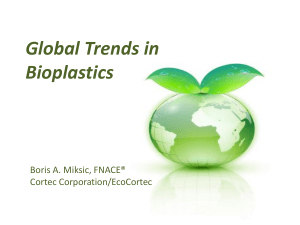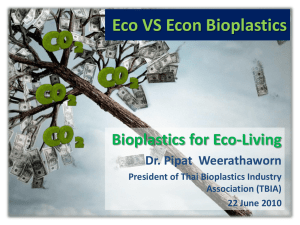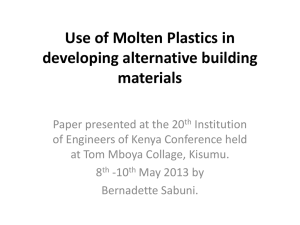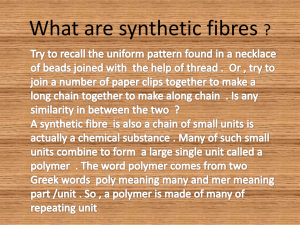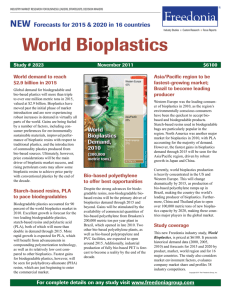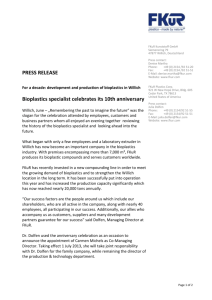application of bioplastics in bulk packaging
advertisement
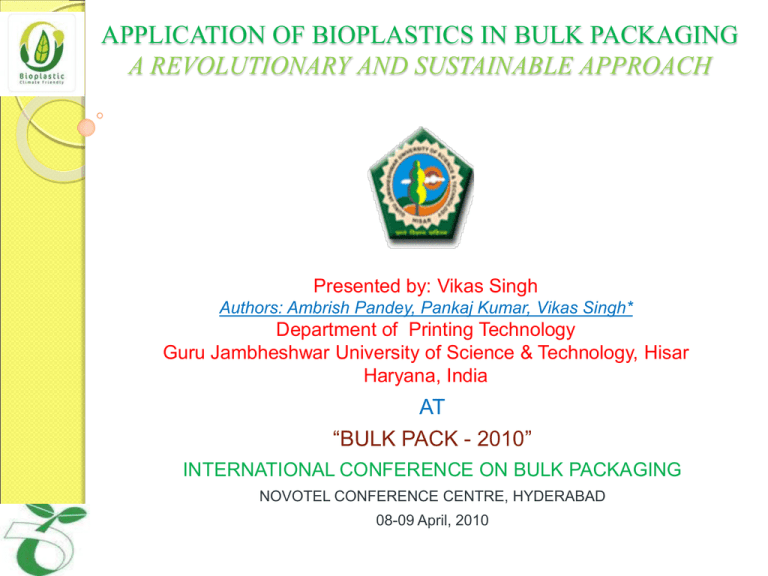
APPLICATION OF BIOPLASTICS IN BULK PACKAGING A REVOLUTIONARY AND SUSTAINABLE APPROACH Presented by: Vikas Singh Authors: Ambrish Pandey, Pankaj Kumar, Vikas Singh* Department of Printing Technology Guru Jambheshwar University of Science & Technology, Hisar Haryana, India AT “BULK PACK - 2010” INTERNATIONAL CONFERENCE ON BULK PACKAGING NOVOTEL CONFERENCE CENTRE, HYDERABAD 08-09 April, 2010 INTRODUCTION Bio-Plastics are not a single class of polymers but rather a family of products which can vary considerably. Bio-Plastics consist of – Biobased plastics, based on renewable resources – Biodegradable polymers, which meet all criteria of scientifically recognized norms for biodegradability and compostability. From recent past, the world is becoming cognizant about the hazardous effect of plastic bags on the environment. To support this, researchers have come up with natural option of Bioplastics. Plastics are being used all over the world. Right from drinking cups to parts for automobiles. Plastics are extremely important to the job market as well as for packaging throughout the world. Since plastics are involved with peoples everyday lives. Therefore production of biodegradable plastics to make plastics more compatible with environment has become necessary. 2 WHAT IS BIOPLASTIC? Bioplastics are a form of plastic derived from renewable biomass source, such as vegetable oil, corn-starch, potato-starch or microbia, rather than fossil-fuel plastics which are derived from petroleum. Bioplastics are not new, in the 1850s, a British chemist created plastics from cellulose, a derivative of wood pulp. Later in the early 20th century, Henry ford experimented with soy-based plastics in his automobiles. After that, biodegradable plastics began being sparking interest during the oil-crisis in seventies. The 1980's brought items such as biodegradable films, sheets and mold-forming materials. 3 COMPOSITION Bioplastics can be made from many different sources and materials: Plant Oil Cellulose Corn Starch Potato Starch Sugarcane Hemp etc. 4 COMPOSITION Plant Oil Corn Contd… Starch Cellulose Sugarcane Potato 5 Classification of Bioplastics Starch based plastics Bioplastics produced from classical chemical synthesis from biobased monomers Polylactic Acid (PLA) plastics Bioplastics produced directly by natural or genetically modified organisms Polyamides 11 Polycaprolactones 6 Introduction to BULK PACKAGING Packaging is system of preparing goods for transport, distribution storage, retailing and end use. It is means of safe delivery to ultimate consumer in sound condition at economic cost. There are basically three different kind of packages categorized on the basis of use, function, containment of the package. 7 Bulk Packaging Systems Intermediate bulk containers (IBC) Flexible intermediate bulk containers (FIBC) Woven sacks Bulk shrink wrap Stretch wrapping 8 Conventional Plastics used in Bulk Packaging The main fossil fuel based plastics used in the bulk packaging are: LDPE LLDPE HDPE PP PVC Nylon Polyester 9 Comparison of Properties of Plastic and Bioplastic PROPERTIES OF BIOPLASTICS (ASTM standard) Physical properties Mold shrinkage 0.0125-0.0155 in/in Density 1.4g/cm³ Apparent viscosity(180ºC, sec¯¹) 950 Pa-s 100 Thermal properties Melting point 160-165ºC Heat distortion temperature 143ºC 78ºC Vicat softening temperature Mechanical properties 147ºC Tensile strength 26 MPa(3800psi) Shrinkage 0.93% caliper Tensile modulus 3400 MPa(494,000psi) Tensile elongation brake 3% Compressive yield Stength Compressive Modulus 65MPa (approx) Flexural strength 44 MPa(6390psi) Izod impact strength 26 J/m(0.5 ft lbs/in) Hardness 54 shore D(90ºC,2.16kg) Bending module 387 MPa 2GPa (approx) 10 PERFORMANCE BASED PROPERTIES OF PLASTIC & BIOPLASTIC Plastics Water vapour transmi ssion rate g/m²,38 ºC, 90% RH Gas transmission Heat rate cc/m², seal 24h/atm at 25ºc rate, ºC Moisture absorption 0.16% (23ºC, 50% RH) O² CO² Transparency High LDPE HDPE 18.6 4.6-100 7750 2868 41850 8990 158-176 162-169 Oxygen barrier Medium-high Polypro pylene 6.2-100 23253720 7750 170-188 Stackability Fair PVC 60 124-465 310-465 158-176 Puncture Resistance Excellent Nylon 388 40.3 Crystallinity 60 155-186 176-220 11 Comparison Of Performance Based Properties 12 Contd… 13 ADVANTAGES OF BIOPLASTICS The need of replacement for the petroleum based plastic with bioplastics is just because Producing conventional plastics consumes 65% more energy than producing bioplastic. Conventional plastic are mostly toxic. Plastics last a long time and do huge damage to environment. Therefore, plastic is absolutely unsustainable and bioplastic is more sustainable. Bioplastics saves 30-80% of the greenhouse gas emissions and provide longer shelf-life than normal plastic. 14 Bioplastics have following several other important advantages over conventional plastics in bulk packaging which are as follows Compost derived in part from bioplastics increases the soil organic content as well as water and nutrient retention, with reducing chemical inputs and suppressing plant diseases. Starch-based bioplastics have been shown to degrade 10 to 20 times quicker than conventional plastics. On burning traditional plastics, create toxic fumes which can be harmful to people's health and the environment. If any biodegradable films are burned, there is little, if any, toxic chemicals or fumes released into the air. Safe Biodegradability Safe for Medicinal Use Compared to conventional plastics derived from petroleum, bio-based polymers have more diverse stereochemistry and architecture of side chains which enables research scientists a great number of opportunities to customize the properties of the final packaging material. 15 MARKET & PRICE OF BIOPLASTIC Bioplastics make up about 0.1% of the global market at an approximate consumption volume of 300,000 tonnes per year and experts predict that this market will grow six-fold by 2011 reaching over 1.5 million tonnes per year. According to European Bioplastics Association, the global production capacity for bioplastics is projected to grow four times by 2020. The prices of any biopolymer are likely to be high when it is only produced on a small scale. The scale of production is likely to have a greater influence on the price than the costs of the raw material source and of the chemistry involved. Today prices are bit high but at higher scales of production the price will fall to a range of 1 to 10USD per kg. 16 CONCLUSION Comparing the properties of biobased polymeric materials with the conventional synthetic petroleum derived polymers shows a major potential of these polymers for the production of well-performing bulk packages. The biobased materials have an inherent potential of being compostable which must help the commercialization of these materials. As with any emerging technology, continued innovation and global support is essential for bioplastics too for fully demonstrate for its socio-economic benefits and further challenge the status of traditional petroleum based plastics in the field of bulk packaging. In social context biodegradable plastics call for a reexamination of life-styles. They will require separate collection, involvement of the general public, greater community responsibility in installing recycling systems, etc. On the question of cost, awareness may often be lacking of the significance of both disposal and the environmental costs, which are to be added to the processing cost. The developments in the fields of bioplastics looks very promising given the fact that compositions of bioplastics are inexpensive, available annually biodegradable in several environments and incinerable. Thus we can use the bioplastics in our bulk packaging systems where conventional plastic is basically used and save our environment. 17 ACKNOWLEDGEMENT The authors are thankful and acknowledge the efforts of the authors of the referred books, papers, websites and the help and support received from colleagues specially Dr. C.P.Kaushik, Assistant Professor, Department of Applied Chemistry, GJUS&T, Hisar Haryana 18 REFERENCES www.science.org.au www.rfsung.org www.zerowaste.co.nz www.greenplastics.com www.eng.iastate.edu www.packaging-gateway.com www.bioplastics24.com Biodegradable Plastics by Dr. A. K. Mohanty Weber, C.J. (Ed.). (2000). Biobased Packaging Materials for the Food Industry. www.packagingknowledge.com\degradable&biodegrad able bags.html Technical Data Sheets. Novamont, www.novamont.com/ing/html/home.html http://www.plastictechnology.com/articles/200209fa3.h tml P. Halley. Biodegradable packaging for food industry. Package bottling int. vol 4, no4, pp 56-57 Plastics in packaging by A. S. Athalye, pp 61-75, pp 183-210 Handbook Of Package Engineering (2nd edition) by Joseph F. Hanlol, pp 8-1 8-83 www.nia.or.th/bioplastics. www.azocleantech.com/details.asp?news www.biomatnet.org/secure/Air/s235.htm www.researchandmarket.com/reprtinfo.asp? www.biodeg.net Green Plastic: an introduction to the new science of biodegradable plastics (2002) by E.S. Stevens, pp 118126 Degradable Polymers (Principles and Applications), 2nd edition by Gerald Scott, pp 295-316 pp 379-400 Article on Biodegradable Packaging for food industry by I.P. Paltani & G.K. Goyal, NDRI, Karnal Innovations in Food packaging by Jung H. Han, pp 240-243 Article on Biodegradable polymers: A rebirth of plastic by Shellie Berkesch, MSU, March 2005 Article on Innovative Technologies for Biodegradable Packaging by Lillian Liu, SJSU, Feb 2006 Processing & Characterization of Bio-Plastics (Presentation) by Yanir Shaked, UOM, Massachutes 19 20
